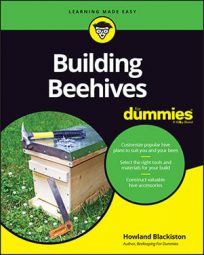The following tables break down the Kenya top-bar hive into its individual components and provide instructions on how to cut and build those components.
Lumber in a store is identified by its nominal size, which is its rough dimension before it’s trimmed and sanded to its finished size at the lumber mill. The actual finished dimensions are always slightly different from the nominal dimensions.
For example, what a lumberyard calls 1 inch x 6 inch lumber is in fact 3/4 inch x 5-1/2 inch, and 4 inch x 4 inch posts are actually 3-1/2 inch x 3-1/2 inch. In the following tables, each Material column lists nominal dimensions, and each Dimensions column lists the actual, final measurements.
You can adjust the height of the elevated hive stand to suit your needs by adjusting the length of the 4 inch x 4 inch cedar posts. Longer legs result in less bending over during inspections.
Elevated hive stand
| Quantity | Material | Dimensions | Notes |
|---|---|---|---|
| 4 | 4" x 4" cedar posts | 12-1/2" x 3-1/2" x 3-1/2” | These are the leg posts of the stand. Rabbet 5-1/2" x 3/4" deep along one end of each post (this rabbet accommodates the long sides of the stand). |
| 4 | 1" x 6" clear pine | 24" x 5-1/2" x 3/4" | Two of these are the short sides of the stand and the other two are the wide struts for the top. |
| 2 | 1" x 6" clear pine | 36-1/2" x 5-1/2" x 3/4" | These are the long sides of the stand. |
| 5 | 1" x 6" clear pine | 24" x 2-1/4" x 3/4" | These are the narrow struts for the top. |
![[Credit: Illustration by Felix Freudzon, Freudzon Design]](https://www.dummies.com/wp-content/uploads/356534.image0.jpg)
Hive body
| Quantity | Material | Dimensions | Notes |
|---|---|---|---|
| 2 | 1" x 12" knotty pine | 34-1/2" x 10-3/8" x 3/4" | These are the long sides. Bevel the top long edge so that the outside height measurement of the board is 9" while the inside height measurement remains at 10-3/8". This provides the necessary slope to accommodate the inclined roof boards. |
| 2 | 1" x 12" knotty pine | 18" x 11-1/4" x 3/4” | These are the V-shaped end panels. The top edge is 18" and the bottom edge is 5-1/8". These dimensions are centered, and they’re what determine the V shape of this piece. Drill seven 3/4" ventilation/access holes into one of the end panels (see the following figures for the approximate placement of the holes). |
| 1 | #8 hardware cloth | 36-1/2" x 7-3/4" | This is the screened bottom of the hive; staple it in place as indicated in the drawing. |
![[Credit: Illustration by Felix Freudzon, Freudzon Design]](https://www.dummies.com/wp-content/uploads/356535.image1.jpg)
![[Credit: Illustration by Felix Freudzon, Freudzon Design]](https://www.dummies.com/wp-content/uploads/356536.image2.jpg)
Top bars
| Quantity | Material | Dimensions | Notes |
|---|---|---|---|
| 28 | 1" x 12" knotty pine | 19-1/8" x 15/16" x 3/4” | Cut a saw kerf on one side centered along the entire length, 1/8" wide by ¼" deep (you’ll glue a starter strip of wood into this groove). |
| 28 | 3/32" balsa wood | 13-5/8" x 3/4" x 3/32" | These are the starter strips that you glue into the kerf cut groove. |
![[Credit: Illustration by Felix Freudzon, Freudzon Design]](https://www.dummies.com/wp-content/uploads/356537.image3.jpg)
Ventilated roof
| Quantity | Material | Dimensions | Notes |
|---|---|---|---|
| 2 | 1" x 12" knotty pine | 36-1/2" x 10-7/8" x ¾" | These are the inclined roof boards. |
| 2 | 1" x 12" knotty pine | 22" x 4-3/4" x 3/4" | These are the roof gables. Cut into a V shape by leaving a 1" rise at the bottom and a 1-5/8" flat cap at the top (see the following figures for details). |
| 1 | 1" x 12" knotty pine | 40" x 1-3/4" x ¾" | This is the roof ridge. |
| 1 | 1" x 12" knotty pine | 6-1/4" x 2-3/4" x 3/4" | This is the roof support wedge. Cut into a V shape by leaving a 1-5/8" rise at the bottom (see the figures for details). |
![[Credit: Illustration by Felix Freudzon, Freudzon Design]](https://www.dummies.com/wp-content/uploads/356538.image4.jpg)
![[Credit: Illustration by Felix Freudzon, Freudzon Design]](https://www.dummies.com/wp-content/uploads/356539.image5.jpg)

